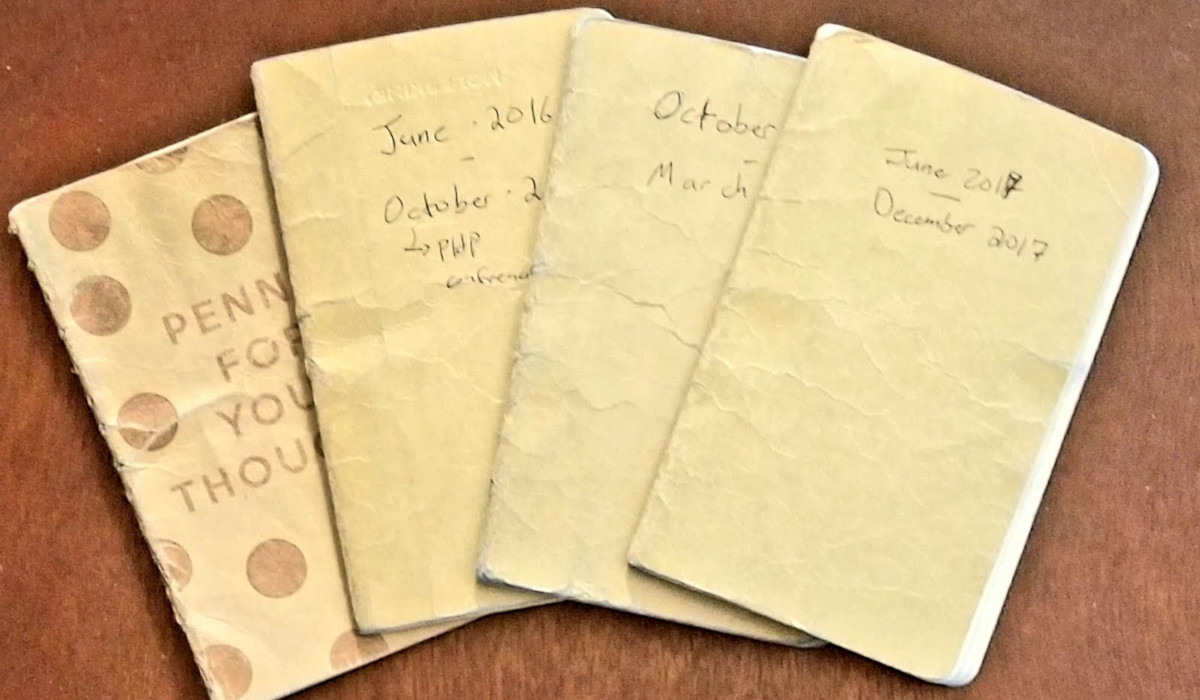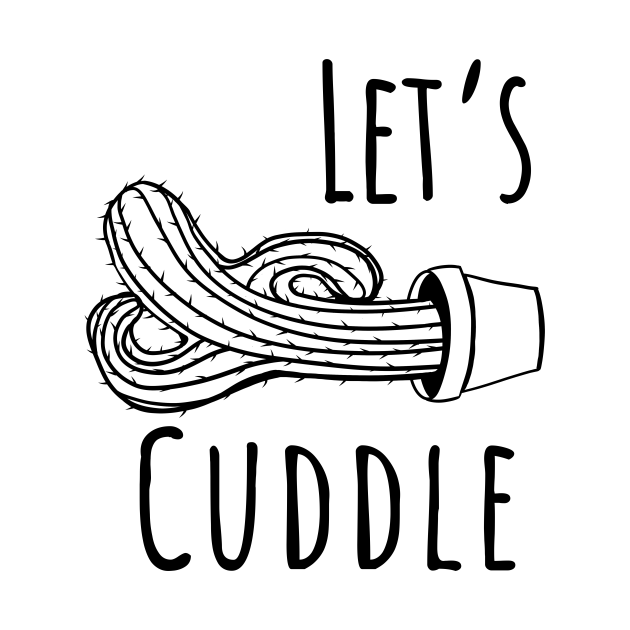For as long as I can remember I have been forgetting things. Usually by the time I’ve finished hearing something from someone it has exited my mind because something else has taken my attention. You may think I have ADHD, my therapist would disagree. My problem is that there is always a task running in the background, something else to attend to, something else to think about.
There is this chatter of things that I could be doing at any time of the day. What I’ve found to help me quiet the background noise and help me focus is keeping a small notebook on me at all times. When I write down things, I don’t have to rely on my brain to remind me of all the tasks I have going on.
I have carried a Field Notes like notebook from Moleskin probably since 2014. It is a small notebook that fits about perfectly in my back pocket. Moleskin calls it a cahier, not caShier (I learned that while writing this article).
Its compact size and the fact that guys have real pockets (women’s pants are ridiculous) lets me keep a notepad and a pen on me wherever I go. Having this notepad I find has a lot of benefits:
- No app to load.
- Can draw if needed without having to change modes.
- Tear off a sheet and give it to someone.
- No looking like a jerk when I take out my phone to write a note.
- I can write and know exactly where to look for it.
This can be weighed with the cons and counter points such as
- Easily lost
- Can’t email a piece of paper. could just message/text them
- Doesn’t work in the dark
- No online backup
Even though these cons are real and have all happened to me the convience of a pad of paper and pen have outweighed them. I needed as few barriers as possible to getting thoughts out of my head. I wanted to focus on the task at hand and get to stuff when I had the chance.
Getting stuff done
The idea of having a notebook started with reading the first chapter of Getting Things Done by David Allen where he talked about how we go through our day with a lot of “stuff” going on in our head and our brain will constantly remind us about them through the day. The problem we have is that our brains don’t remind us about stuff when we can actually do something about them.
So what we need to have is a place to store those thoughts for later when we have the time and ability to do something about them. Writing down these thoughts frees our mental space to think and do the task at hand.
There is no reason to ever have the same thought twice, unless you like having that thought.
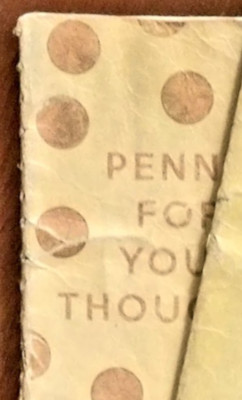 Then I saw an add from Draplin Design about his Field Notes pocket books. These fit the bill exactly for having something close that is fast to jot ideas onto. I didn’t buy it right away because I saw something similar enough at the store I worked at and that got it into my hands to try this idea out.
Then I saw an add from Draplin Design about his Field Notes pocket books. These fit the bill exactly for having something close that is fast to jot ideas onto. I didn’t buy it right away because I saw something similar enough at the store I worked at and that got it into my hands to try this idea out.
Early notebooks
The first attempt I got at these were pretty discombobulated and unorganized. Just sporadic jotted down notes.
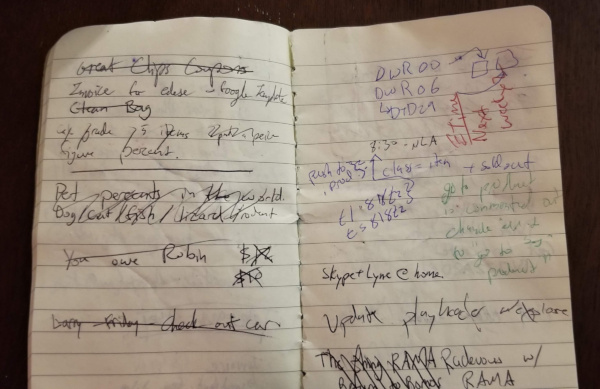
So it got really hard to use and track what was going on. This also prevented me from referencing it ever. So it failed as an effective tool. I continued to keep it on me because the convenience of having paper and pen was worth having on hand. The first notebook had straight lines and that didn’t jive well with me as I needed space to doodle and write outside the lines. I found a set that had grid paper.
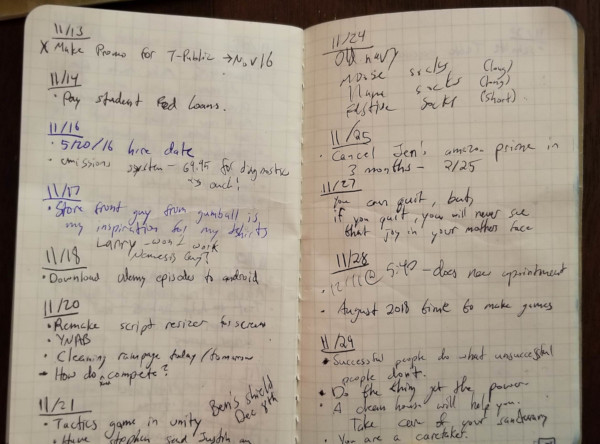
And I stuck with the grid paper for a long time and it worked really well. It allowed me to do gird systems for calendars and line up lists, I was really happy with it.
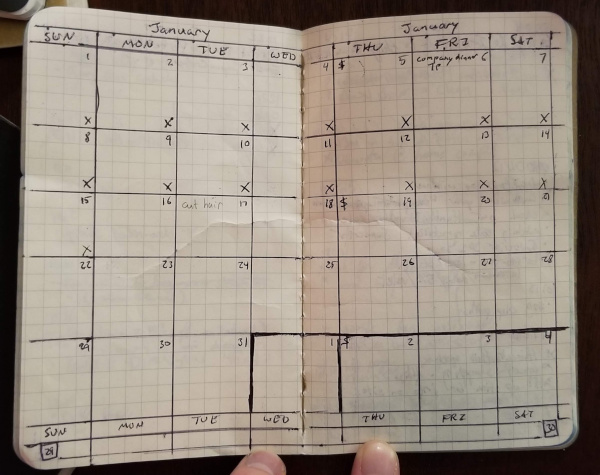
I bought a lot of Moleskin notepads from Barnes and Noble because they were there taunting me to buy them in the store. Still the lines got in the way of making things legible when reading the pages. I finally got my hands on a Moleskin dotted grid and will only buy these from now on. They are the closest to what a official Bullet Journal has and it has enough structure to let me write but enough space for me to draw and get outside the lines.
Upgrading My Notes
In my time of taking these notes I have learned a few things. First thing I saw was the Bullet Journal video and it introduced me to the dot grid and an actual syntax to taking notes. I have also read a couple books that have influenced how I take notes now.
Intro to Bullet Journal
There are four components to using a Bullet Journal the Index, Future Log, Monthly Log, and the Daily Log.
Index This is where you write down page numbers where your Future log and months start and end. I improved this a little by marking the edge of the section with my pen. This kind of simulates the way a dictionary has markers that denote the section of the alphebet. For me it is for months.
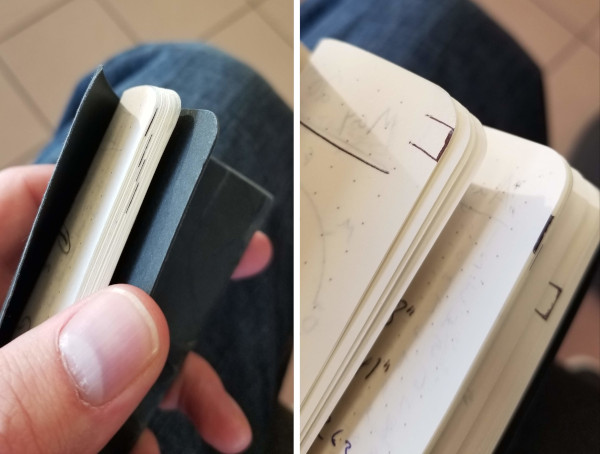
I tried to use a ribbon, a bookmark, even a rubber band. But with this going into and out of my pocket constantly they quickly got lost or torn. I can’t mark my exact page with this method but being brought to the month is close enough and lets me review what is going on that month often.
My Index is updated mostly when I make a special list so I know it is in there. My special lists typically have a mark on the top instead of on the side. And they include books to read, shopping lists, routines, notes from a meeting, pretty much anything that isn’t a Daily log.
Future Log The future log in a Bullet Journal lets you map out the whole year of special events. Unfortunately with the pocket notebook this takes up too much space and is really hard for me to use because they can last from anywhere between 3 months to a full year. Some months just don’t have a whole lot going on. So I have removed this from my pocket Bullet Journal.
Monthly Log I use this at the start of every month and mark it on the edge of the page so I can schedule appointments and birthdays that are in that month.
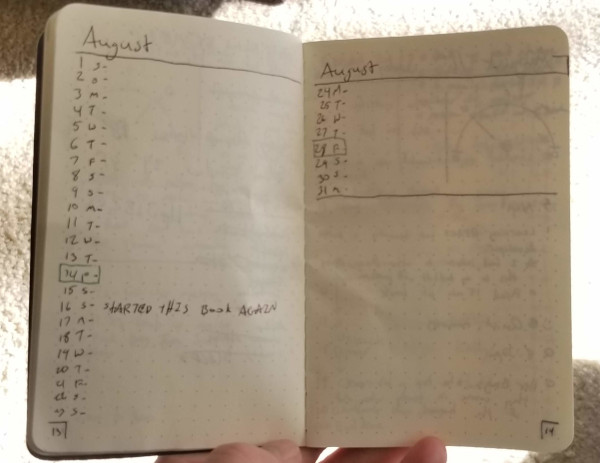
This doesn’t replace my calendar app on my phone but the backup and speed to look up stuff is great. There is a drawback when something gets canceled I can’t delete it out of the book. Still there is space at the end of the calendar that lets me take notes that affect the month.
Daily Log The daily log is really what made this setup shine. It has a method to write down tasks and what you are going to do with them. I have modified them to work with my pocket Bullet Journal
[ ] Task
[/] Partially completed task
[x] Completed task
Moved to next day
Cancelled
- Note
There are more things that are in the Bullet Journal method that you can use, these are mine and I use them often.
It is suggested to put a glossary of terms and symbols at the back of your Bullet Journal to reference later so you don’t forget what each one means.
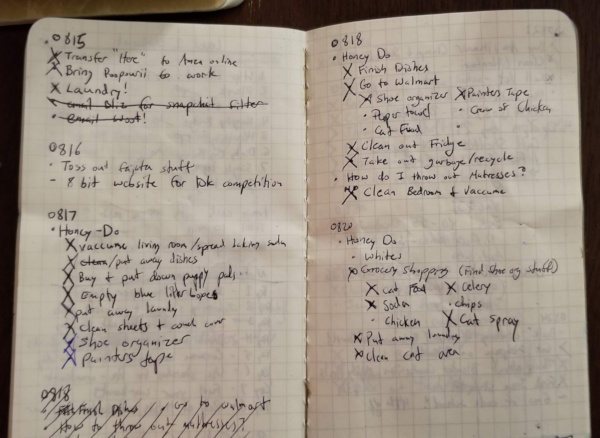
My Little 5 Second Journal
I saw an image that showed the 5 Second Journal by Mel Robbins’s pages and I adapted it to my pocket journal.
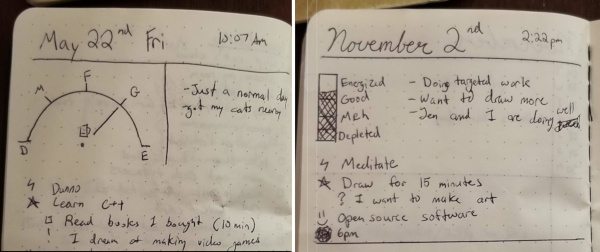
The one on the left was closer to what is pictured in the 5 Second Journal. I adapted it to the one on the right because drawing a half circle freehand is tough. I used a bottlecap for a long time but I didn’t always have one around. 🤷♂️
The layout is similar and I use symbols to indicate writing prompts.
There is the “How energized do I feel” meter. Ranging from Depleted to Energized. The prompt to why I feel that way next to it. I try and list three things every day. Then below it we have these prompts that have been shortened to symbols.
- Lightning Bolt: What can I do to feel more energized
- Star: What is one task that I can do today to move me closer to a personal goal.
- Question Mark: Why is that goal important to me?
- Smiley face: What is something I am grateful for right now?
My older journal had these
- Star: What is a dream I have
- Task box: What is one task I can do to get closer to that dream
- Exclamation point: Why is this dream important to me.
I combine the dream and task into one to take up less space and I’m more focused on the task towards the dream than what the dream is.
Little Lettering for Planners
Lettering for Planners has gotten me inspired to use some fancy text on my journal and at first I really embraced it and did a whole lot of fancy things. Then time became an issue and I’ve slimmed it down considerably.
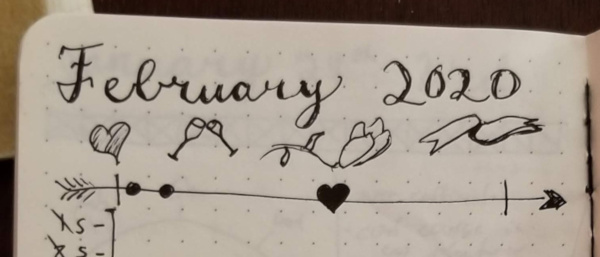
So now just the month is fancy. It gives it enough flavor to set the heading apart from the rest of the simple text. I don’t think I’ll ever get the amazing designs that people have in the planners on Instagram. I am focused more on function and speed so that is okay. I’ve tried to experiment with colors because I carry a four colored pen on me usually but, it made it too busy for me to keep track. I chose this pen specifically because the tip is pocket friendly.
Adam’s Lists
Every Tool’s a Hammer really opened my eyes on making better lists and inspired me to draw more in my journal. The way I see it, if I’m not making a list on the page I might as well doodle.
The way Adam approaches lists is that he has a ton of them. He makes a first list that is just a brain dump about every little thing that will be involved in a project. A rough draft list if you will. Then he sets to break that down and make it more manageable to use.
One of his biggest epiphany was partially filling in task boxes so that way he knows it is started but not finished yet. This really jives with my idea to task making and fits in my notebook.
Usually my tasks remain unfinished but a half box helps me look back and see that I did something towards my goal.
In this book the topic of drawing is explored as part of the making process and how everyone needs to draw. From programmers to day care managers. Drawing helps explore and unlock solutions you wouldn’t have though of otherwise. It is a crucial part to any problem solving. Because of this I am working to evolve my pocket Bullet Journal to include more doodles even if they aren’t project based.
Where I am at today
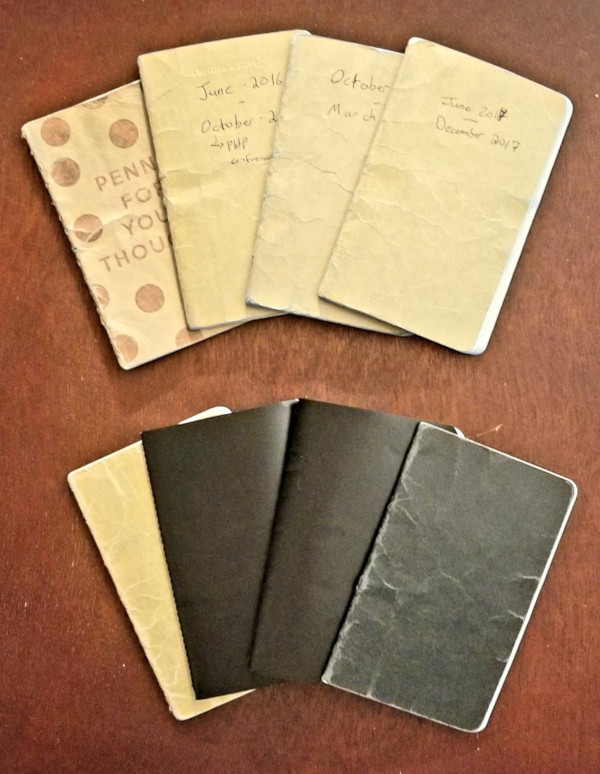
My pocket notebook is still with me wherever I go and I write in it just about every day. If only to track my mood and gratitude, the things that the 5 Second Journal helps you track. This ritual lets me take a pause before starting everything else in the day. Having the notepad around makes sure that when a great idea pops into my head I can jot it down.
Like this t-shirt design of mine was in my notepad for a long time before I got the time to make it.
A technology companion, not a replacement
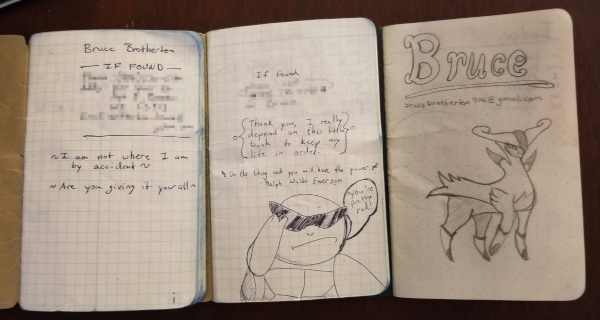
This notebook while great isn’t a replacement for modern technology. It is a semi permanent spot to put thoughts in the moment. If it is a thought I need to keep or get reminded of I need to get it into a calendar or note taking app.
Part of making that work is getting apps that work best for you. A couple that I like to use are One Note by Microsoft and Paper by Dropbox. I actually do all my rough draft work for my posts in Paper. I like that you can use Markdown in it for formatting. I also use Google Calendar to schedule things, but when I am at the Dentist desk I write it down in my notebook. That works out really good because I can make side notes about it right then and there.
I am constantly changing and updating methods that work best for me in this little notepad. Still learning best practices and finding ways to intergrade my daily habits into it.
This may not work for everyone but it is something that I have found useful over the years. I hope this article will help you figure out a way for you to organize and remember your thoughts too. That’s all for now.
I have put together a list of links to help you research a little further on things I’ve touched in the article. Full disclosure, these are Amazon Affiliate links and I will be getting a kickback off the sale of the books linked. If you would rather not support the Amazon giant, I understand.
Resources
- Products
- Books
- Apps
- Additional Resources
- 5 Second Rule, I highly recommend it to help you kickstart your journey in productivity.
